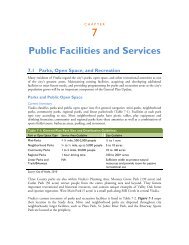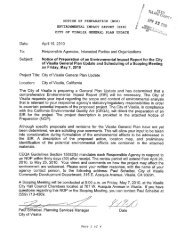General Plan Update Review Committee Draft Elements Part 2 For ...
General Plan Update Review Committee Draft Elements Part 2 For ...
General Plan Update Review Committee Draft Elements Part 2 For ...
Create successful ePaper yourself
Turn your PDF publications into a flip-book with our unique Google optimized e-Paper software.
7-2<br />
VISALIA GENERAL PLAN UPDATE<br />
sion layers in the winter, create a climate conducive to<br />
high concentrations of certain air pollutants.<br />
The SJVAB is basically a flat area bordered on the<br />
east by the Sierra Nevada Mountains; on the west by<br />
the Coast Ranges; and to the south by the Tehachapi<br />
Mountains. Airflow in the SJVAB is primarily influenced<br />
by marine air that enters through the Carquinez<br />
Straits where the San Joaquin-Sacramento Delta<br />
empties into the San Francisco Bay. The region’s<br />
topographic features restrict air movement through<br />
and out of the basin. As a result, the SJVAB is highly<br />
susceptible to pollutant accumulation over time. Frequent<br />
transport of pollutants into the SJVAB from<br />
upwind sources also contributes to poor air quality.<br />
Air Quality Regulatory System<br />
Federal and State laws require emission control measures<br />
in areas where air pollution exceeds standards.<br />
The San Joaquin Valley is one of these areas. The<br />
federal government, primarily through the Environmental<br />
Protection Agency (EPA) and the federal<br />
Clean Air Act, sets standards, oversees state and local<br />
actions, and implements programs for toxic air pollutants,<br />
heavy-duty trucks, locomotives, ships, aircraft,<br />
off-road diesel equipment, and some types of<br />
industrial equipment. Currently, EPA has established<br />
national standards for criteria air pollutants:<br />
ozone (O ); carbon monoxide (CO); nitrogen dioxide<br />
3<br />
(NO ); sulfur dioxide (SO ); suspended particulate<br />
2 2<br />
matter (PM-10 and PM-2.5); and lead (Pb).<br />
Pursuant to the California Clean Air Act of 1988, the<br />
State government, through the Air Resources Board<br />
(CARB) and Bureau of Automotive Repair, set more<br />
stringent state standards, oversees local actions, and<br />
implements programs for motor vehicle emissions,<br />
fuels, and smog checks.<br />
The San Joaquin Valley Air Pollution Control District<br />
(SJVAPCD) was established in 1991 to administer<br />
local, state, and federal air quality management<br />
programs and implement control measures.<br />
The SJVAPCD is responsible for developing attainment<br />
plans for the San Joaquin Valley Air Basin, for<br />
inclusion in California’s State Implementation <strong>Plan</strong><br />
(SIP), as well as establishing and enforcing air pollution<br />
control rules and regulations. The attainment<br />
plans must demonstrate compliance with federal and<br />
state ambient air quality standards, and must first be<br />
approved by CARB before inclusion into the SIP. The<br />
SJVAPCD regulates, permits, and inspects stationary<br />
sources of air pollution.<br />
SJVAPCD also administers the Air Toxics “Hot<br />
Spots” Program which involves reviewing new stationary<br />
sources to ensure compliance with required<br />
emission controls and limits, maintaining an inventory<br />
of existing stationary sources of toxic air contaminants,<br />
and developing new rules and regulations<br />
to reduce toxic air contaminant emissions.<br />
Local cities and counties are responsible for implementing<br />
air friendly community planning that promotes<br />
pedestrian traffic, commute alternatives and<br />
cleaner transit fleets. They can also regulate odors<br />
and nuisances and the release of particulate matter at<br />
construction sites.<br />
Criteria Air Pollutants<br />
As required by the Federal Clean Air Act passed in<br />
1977, EPA has identified six criteria air pollutants that<br />
are pervasive in urban environments and for which




